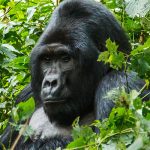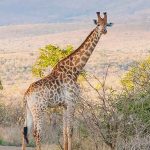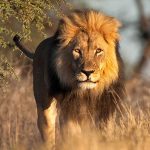Africa’s incredible wildlife is the central reason to go on safari. Micato Safaris share their tips on ensuring your photographs are as vivid as the memories you’ve made.
Tips for Taking the Best Safari Photos
By Micato Staff
Taking beautiful photographs is an enormously important part of the safari experience for many of today’s travellers. Some Micato guests return home with gallery-style images to frame as mementos of their African adventures; for others, the goal is to share dazzling pictures with friends, family, and followers on social media.
 Given the gorgeous landscapes and abundant wildlife of Africa’s game preserves, it’s easy to imagine that snapping perfect safari photos would be just that: a snap. The truth, though, is that using the right equipment, and identifying the best angles and light conditions, can make a huge difference in the quality of your pictures. Following a few key tips, like those below, can maximize your chances of capturing stunning images (and also bumping up your Instagram “likes”).
Given the gorgeous landscapes and abundant wildlife of Africa’s game preserves, it’s easy to imagine that snapping perfect safari photos would be just that: a snap. The truth, though, is that using the right equipment, and identifying the best angles and light conditions, can make a huge difference in the quality of your pictures. Following a few key tips, like those below, can maximize your chances of capturing stunning images (and also bumping up your Instagram “likes”).
Choose the right gear. Taking photos with your smartphone may work just fine in everyday life, but for a once-in-a-lifetime experience like safari, you’ll want to upgrade your kit. That means investing in (or renting) a good-quality DSLR camera, as well as two lenses: a wide-angle option for sweeping landscape shots; and a zoom lens (preferably at least 300mm or 400mm) for portraits and wildlife close-ups. Since you’ll likely take many of your photos from inside a safari vehicle, you will appreciate that all Micato Safari vehicles are stocked with beanbags to help steady your camera while moving (a tripod really only works if you’re going to be standing still on the ground). And don’t forget extra batteries and memory cards—you’re likely to take thousands of photos on your trip.
Shoot early—and late. Lighting is critically important when taking photographs, and shooting in Africa’s bright, wide-open natural landscapes can present particular light challenges. In general, it’s best to avoid taking safari pictures in the harsh overhead sunlight of mid-day—and instead plan to shoot in the early morning and late afternoon, when the sun’s light is softer and more golden, and casts more striking shadows. (Happily, since these cooler hours are when animals are most active, they are also when most game drives take place.)
 Use optimal settings. While there are no specific camera settings that will guarantee your photos come out great (the settings you choose will be dependent on your subject matter, shooting conditions, and your camera), a couple of basic rules can be useful to keep in mind. When shooting landscapes, choosing a narrow aperture and a slower shutter speed (or, if your camera has auto settings, choosing “landscape mode”), will help create grander scenes, where both the foreground and background are in sharp focus. When shooting wildlife—especially on the move—it’s best to switch to a wide aperture and quick shutter speed (also achieved by using “portrait mode”). This will result in freeze-frame-style images, where background elements like trees and grasses are blurred, but your subject—a running cheetah, a hovering kingfisher—stays crystal-clear.
Use optimal settings. While there are no specific camera settings that will guarantee your photos come out great (the settings you choose will be dependent on your subject matter, shooting conditions, and your camera), a couple of basic rules can be useful to keep in mind. When shooting landscapes, choosing a narrow aperture and a slower shutter speed (or, if your camera has auto settings, choosing “landscape mode”), will help create grander scenes, where both the foreground and background are in sharp focus. When shooting wildlife—especially on the move—it’s best to switch to a wide aperture and quick shutter speed (also achieved by using “portrait mode”). This will result in freeze-frame-style images, where background elements like trees and grasses are blurred, but your subject—a running cheetah, a hovering kingfisher—stays crystal-clear.
Be patient. With so many animals to see in Africa’s game preserves, it’s understandable that you might want to move on after snapping a few photos of a single elephant herd or family of giraffes. But, as professional wildlife photographers (and Micato Safari Directors) know, the best images often come from staying in one place for a while, and continuing to observe and shoot. A pair of zebras may pick up their heads from grazing so their body positions perfectly mirror one another; a lion that seems to be dozing in the shade may suddenly, thrillingly, open its eyes.
Be respectful. While it’s tempting to want to get as close as possible to wildlife for more arresting photos, it’s important—for the animals’ safety and for yours—to stay at a respectful distance. Your Micato Safari Director, an expert in African species, will make sure your vehicle only approaches animals in a manner that won’t disturb them. But you can do your part, too, by disabling your camera’s flash—which can disorient and temporarily blind the creatures you’re shooting.
 You’ll want to use a similar sense of propriety when photographing local people while on safari. Many tribes people who live and work on game preserves are used to having their pictures taken; still, it is always better to ask. If a person you want to photograph seems uncomfortable with it, defer to his or her wishes, and stash your camera away.
You’ll want to use a similar sense of propriety when photographing local people while on safari. Many tribes people who live and work on game preserves are used to having their pictures taken; still, it is always better to ask. If a person you want to photograph seems uncomfortable with it, defer to his or her wishes, and stash your camera away.
A Micato safari is sure to leave you with life-changing memories—whether you capture them in photos or not.

